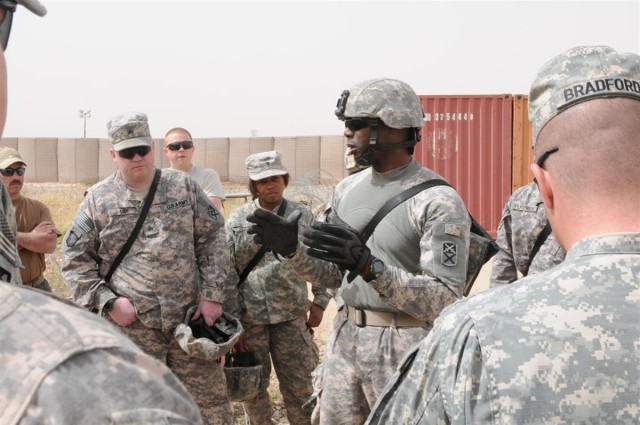
CONTIGENCY OPERATING BASE SPEICHER, Iraq - Improvised explosive devices are the main threat throughout the Iraq Joint Operations Area, and Soldiers were trained to locate them at Contingency Operating Base Speicher, Iraq, March 31.
Soldiers participated in a train-the-trainer level three course, to teach them to be instructors and train their fellow Soldiers.
Electronics War Technician Petty Officer 1st Class Kyle Wood, a counter-improvised explosive device team trainer with the navy intelligence center in Greensborough, N.C., said they train Soldiers throughout Iraq in preparation for their mission.
"We train the Army units that (relief in place) into country," said Wood, a Greensborough, N.C., native. "We're also training a lot of the Iraqi forces, Iraqi police, federal police (and) border patrol on counter-IED training, to improve their abilities while they're outside the wire so they have a better chance of defeating the attacks."
Wood said the level three class certifies the students to train their units.
"I believe it's a very good asset to have out here and it's a good thing that the Army units and the Iraqi units get this training, because it opens their eyes a little more and gives them a good refresher," he said.
During the training, students set up mounted and dismounted lanes for Soldiers to go through and look for IEDs, said Sgt. Bau F. Mader, a truck commander with K Troop, 3rd Squadron, 278th Armored Cavalry Regiment out of Newport, Tenn..
"We set them up and then ran them through in groups of two," he said.
One group set up the lanes while the other went through and tried to identify the IEDs, said Mader, a Jonesborough, Tenn., native. They then discussed why the IEDs were placed in certain spots, and how Soldiers could identify them more easily.
"I think it was good training," he said.
Mader said the level three course covered what Soldiers had learned in prior levels and built upon it.
"Also, we're being exposed to new (tactics, techniques and procedures) that the enemies are using in our (area of operation)," he said. "This training will help us out because it allows us to come and set up this range and to give (our Soldiers) the training that we are receiving."
Sgt. Tilson C. Hargrove, a truck driver with the 2101st Transportation Company out of Demopolis, Ala., 541st Combat Sustainment Support Battalion, 15th Sustainment Brigade, 13th Sustainment Command (Expeditionary), said the course was very detailed in regards to the positioning of the IEDs, their location, how to set them off and what to expect on travel routes.
"I got information on what to expect while I'm out there on the road," said Hargrove, a Boydton, Va., native. "I can take this stuff back to my troops, to give them more (intelligence) on what to look for, what to expect."
Hargrove said it is crucial his Soldiers stay informed.
"We are a transportation company and we're constantly going to be on the road," he said. "We need to know what is out there."

Social Sharing